(Photos: Earl Gardner)
Our two-part look at the Camden Youth Soccer Club concludes with a Q & A with coach Barry Evans. The series began with a photo essay by PSP photographer Earl Gardner.
Philly Soccer Page: Tell me a little bit about your soccer background.
Barry Evans: Coming from Scotland, there is only really one sport you get into, and that is “Soccer” (or football, if I say “football” from here on out, i don’t mean US chuckball). My dad played for a local team, and my uncle actually, Allan Evans, won the European Cup with Aston Villa in 1982 and played for Scotland in the 1982 World Cup—so I would say I have a decent background in the sport. I had played a little, but then got into coaching youth and really enjoyed it. I even managed to coach at Hampden, Scotland’s national stadium.
As for other coaches, we also have a lot of soccer background there. One of the committee members, Jerry Jerome, is actually in the New Jersey Soccer Hall of Fame, and we have coaches from England and the Netherlands, so a lot of “international flair” is brought to the club. Of course, if people want to come along and coach you don’t need to have experience—or even know the game—just a love for helping kids enjoy themselves is all that is needed.
PSP: Ed Bonnette founded the Camden Youth Soccer Club in 2003. At the time, he said, “There’s a need, there’s a void, and we’re filling it.” Tell me about the evolution of the club.
BE: This is something I may have got wrong, as I wasn’t around at the time. But from what I know, Ed and Jerry got together, and decided to start up CYSC. It started off at one of the local high schools, and there was regularly 200-400 people there. Since “HS (US) Football” was moved to a Saturday, we weren’t able to stay at the playing fields, and then ended up at Pyne Poynt Park where we are now. It was started off as a way of bringing the sport to the local kids, as well as giving them a little more stability in what has to be said is tough times for everyone in the area.
PSP: How did you become involved? Do you have ties in Camden?
BE: I had moved to Augusta, Georgia to get a job in 2004, and there was no “soccer” there at all. When my job basically transferred to the area, I got an apartment in Camden. On my way home one day in 2008, I saw one of the signs that the volunteers had put out, and emailed the club to find out more. The club sounded a great idea, so I signed myself up, along with my wife who now helps out with the registration table. I bet the people at CYSC wish they never put a sign up where i could see! Since then, I’ve only missed about four weeks of volunteering at CYSC, and I look forward to it every week.
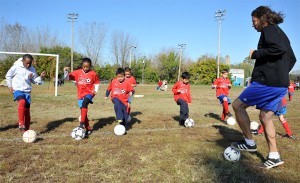 PSP: CYSC’s mission is to work with “giving youth fresh air and a connection with the natural environment” while also “learning the joys of competitive sports.” Tell me about the importance of being able to play soccer in green areas in an urban environment.
PSP: CYSC’s mission is to work with “giving youth fresh air and a connection with the natural environment” while also “learning the joys of competitive sports.” Tell me about the importance of being able to play soccer in green areas in an urban environment.
BE: In Scotland, there are areas where you play on hard ash or concrete only. Obviously, then any time you fall, it hurts. I suppose you could say it put some people out of playing the game. When you are already fighting against more popular US sports, having somewhere nice to play is very important. Being able to go to the park, and run around having fun is something you see less and less nowadays, with a lot of kids staying indoors with their video games. Not only do we want to introduce the kids to a great game, we also want to help keep the kids as healthy as possible. Having a nice park to play in helps with that.
PSP: Can you give me a sense of the impact that soccer has made on the lives of the kids in the club?
BE: Without putting words in peoples mouths, I’d like to think that we have a very positive impact in the lives of the kids. From introducing them to what I feel is by far the best sport in the world, to helping them socialize with others they maybe wouldn’t normally socialize with—there are a lot of good things that the kids get out of the game. The “teamwork” aspect of the sport is far more than any other sport in my eyes, and that is also a positive on their lives. The kids that come back season after season really get a lot of out the club and you can tell that just by seeing how much they enjoy it.
Our treasurer was banking cash through the week, and had his CYSC jersey on. The bank clerk was one of our graduates, and thanked the secretary for CYSC being an important part in their life, and said they were glad that CYSC is still going strong, as it was something he looked forward to. I think it’s a cool story in and of itself.
PSP: Do the kids come into the club with much of a soccer background?
BE: We get a wide variety of “background” within the kids. You have some that have probably never kicked a ball in their lives, and some that share my enthusiasm for the sport. One of the more difficult jobs for our coaches is trying to make our sessions challenging enough for those that know the sport, and enjoyable for those that don’t. What I’d love to see happen is for the kids to come along at 4-6 years old, where all the focus is on getting them used to the ball and having fun. Then when they get to the older age-groups, you don’t have that “barrier” of someone not being familiar enough with soccer. Since the 4-6 year olds are often the biggest group we have, I’d say we are doing well in that respect. Now we just have to keep them as they get older.
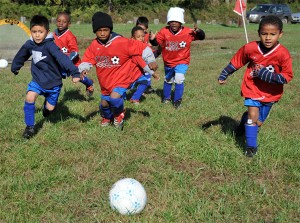 PSP: CYSC is for kids aged 4 to 14. Tell me about the kids who make up the club. How many kids are involved, how many teams are there?
PSP: CYSC is for kids aged 4 to 14. Tell me about the kids who make up the club. How many kids are involved, how many teams are there?
BE: We don’t have “teams” as such, and don’t travel. What we do is split all the kids up into different age groups. We have the “Blue Socks” (4-6yrs), “Black Socks” (7-8yrs), “Red Socks” (9-10yrs) and “White Socks” (11+). Other than the socks, everyone is treated equally, and there are no “captains” or “teams”. We have two “seasons” a year. In the fall between September and Thanksgiving, we will get around 100 kids signing up. In the spring season that goes up to around 200 signups. While we don’t usually get everyone coming every week, it has dropped quite a lot from when CYSC started up—whether that is because of the move away from the high school grounds or just a reflection on issues of the economy, we don’t know. Out of that, maybe 45 percent of the kids are 4-6 years old, 30 percent 7-8, 15 percent 9-10 and 10 percent 11+.
On a typical Saturday, the kids are split up into their groups, have either ball games (4-6 per side) or coaching for about an hour, and then they are split (randomly) into teams of from 4-7 a side, and a game is played within each group. We have a “winning isn’t important” ideal, and try and make it as fun and even as possible.
PSP: Do you find that it is difficult to keep the young kids involved in playing soccer as they grow older?
BE: It does get more difficult to keep kids coming back as time goes on. Whether they just “lose interest,” get into a different sport (we lose a lot in the fall due to high school football), we have no idea. There is always a core of players that come back, and you just have to keep going for those kids, and hope that the others at least learned something.
PSP: What are some of the challenges the kids may face, challenges that may be unique to their background or that are unique to Camden?
BE: Tricky question. I wouldn’t say there is anything that is “unique” to Camden, but it is a poor area. The kids have to work a lot harder to get through than certainly I did, as well as most of your readers probably did. You have to be understanding of that kind of background when you are dealing with them, and it doesn’t make it easy. However, such poverty is becoming a more wide-spread issue, and every “big city area” has it’s bad parts and good parts. Camden just happens to be a bad part of the Philadelphia region.
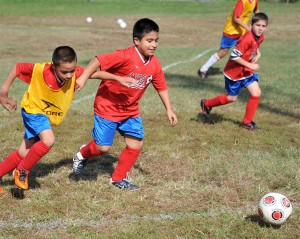 PSP: CYSC’s website describes CYSC as a recreational league. Are there plans to create travel teams to enter in more competitive leagues?
PSP: CYSC’s website describes CYSC as a recreational league. Are there plans to create travel teams to enter in more competitive leagues?
BE: There are no plans on making travel teams right now. There was murmurings a while back apparently, and there have been offers from other groups to bring teams in. But we can have a hard enough time getting people to come regularly, that making a travel team, where you have to be somewhere at a certain time is just not really feasible. Having the sharp drop off in the older kids that come along also means that there aren’t enough kids to really make a travel team. We have had days where other clubs have came along, and instead of having “CYSC vs THEM” we usually go along with our regular routine and mix the teams up. I think that’s more valuable than making a competitive travel team, as the kids will get more out of it.
PSP: CYSC also strives to “Engage the community with the opportunity to become coaches and volunteers.” Tell me about the coaches and volunteers—are they drawn primarily from within Camden?
BE: We have a wide range of volunteers. A lot of those that initially started the club are still around and they do a fantastic job of keeping everything going. We are also always getting a new “influx” of coaches and volunteers. Many are parents who want to help with setting up fields and handing out water during water breaks, and pizza at the end of the day. We have some law students from Rutgers who come along and help out, as well as high school children from Haddonfield who do a fantastic job with the kids. There are also many volunteers who come from outside of Camden who travel for about an hour on their Saturday to come and help out, which is great. It isn’t just the coaches that help run the club—the “background” people as you could call them are probably more vital to running a good program for all the kids to enjoy. We even have some from the Sons of Ben who come along and help out on a Saturday before heading to PPL.
PSP: Are the volunteers primarily motivated by the community-building mission or the desire to help kids learn the game of soccer?
BE: We have a mixture of both, although everyone would say they are motivated by the community building. Those that do the coaching, obviously have to have the desire to help the kids learn the game, but I think everyone would like to be involved in such a program, no matter what sport was involved, because the good you do to the community is worth all the effort you put in. Personally, I am always striving to be the answer to the question “Dear Soccer Star, who has been the most influential person in your career” that a reporter such as yourself would ask, when the player is returning home having won a WC/MLS cup. [laughs]
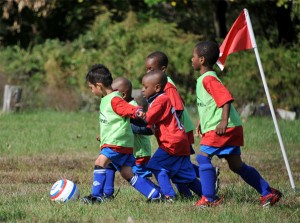 PSP: Tell me about the importance of parental involvement in the success of the club.
PSP: Tell me about the importance of parental involvement in the success of the club.
BE: We require a good deal of parental involvement, too. As I said above, we have a few parents who help out volunteering, without whom we wouldn’t be able to survive. Otherwise, with 1-2 coaches per 8-10 kids at times, and especially for the younger kids – that can be difficult, so we do prefer parents to stick around and at least be able to “supervise,” if required. Of course, the parents also have to keep bringing the kids back week after week, so they are very important there too. Afterwards we get together, our parents are all very good at helping clear up, and that is very much appreciated.
However, I think the biggest plus to parental involvement is always going to be in encouraging the kids, and keeping everything a fun environment. We don’t have the issue at CYSC, but it is every coaches nightmare to have that “interfering parent” that think they know better than the coaches. While they might, that sort of thing never helps. I’d like to thank the parents of the CYSC kids for helping us keep CYSC to be fun for all.
PSP: How much does it cost to join as a player? Do you have assistance available for kids and their families who may find it difficult to afford the cost to join or the cost of equipment?
BE: We like to think that we are one of the best “value for money” clubs around. It is only $10 to register a kid for the season (which goes towards the insurance costs that we have to play). Uniform costs are $25 per child, and we have a deal if you have multiple kids. Once you have that uniform, as long as it doesn’t get lost or too small, you can wear it from season to season. The uniform costs include t-shirt, shorts (all the same), socks and shin-pads. We also have a wide variety of donated cleats if a kid needs a pair, and that is at no cost. We supply the balls, and water throughout the day, as well as (at least for now) pizza at the end of each coaching session. A season lasts nine weeks and, at the end, we usually give out a medal for those that participated.
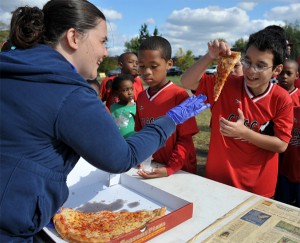 PSP: How do you raise the money to fund the club? Can PSP readers donate to CYSC?
PSP: How do you raise the money to fund the club? Can PSP readers donate to CYSC?
BE: Until now, we have relied heavily on donations from companies and organizations. We haven’t done much fundraising in the past, but with increased costs, that may be about to change. We will never say no to any donation—especially if that donation is time volunteering. The club is a registered non-profit charity, so all funds coming in go out on supplies for the kids.
If someone would like to learn more about the club, they can checkout our website and our FaceBook page. People can donate there using the “Causes” link.
PSP: Has CYSC been on contact with the Philadelphia Union or the Philadelphia Independence for partnership and support?
BE: We have been in touch with the Union several times, but not yet the Independence (next on my to-do list). In the past, we have had some footballs donated to us from the Union, and Shea Salinas visited us last year. Wee actually had Roger Torres come out on Saturday to visit, and just go around talking to the kids, and then sign autographs at the end. While we aren’t able to go into a partnership with them, it is great that the Union actually care about local youth soccer in terms of coming out on visits.
PSP: What is it about the game of soccer that helps it being, in Ed Bonnette’s words, “a social movement” that helps to bring communities together?
BE: I think more than anything it is just a fantastic sport to get into and love. Teamwork is a huge aspect of the game, and everyone can get involved in it whether you are rich or poor—doesn’t cost much, and you don’t need much to play it even on your own. The Union and Independence being around, and being successful too, also helps, and communities can get together to back them. Our volunteer T-shirts have four or five languages on the back of them, and I think that also goes to show that soccer is a game for everyone to have fun and play, whereas that is probably missing in many other sports.
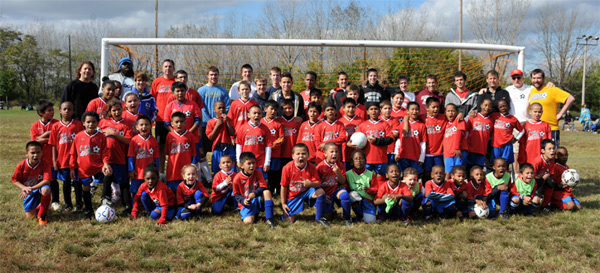
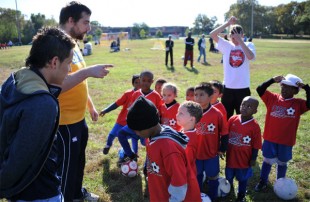

Thanks again to all at PSP – fantastic to have a story about us on a fantastic website. #DOOP on with #CYSC
Another amazing article. Besides having the best UNION coverage I really love your articles on the history of soccer and local youth soccer organizations. DOOP.
Barry and CYSC, keep up the amazing work! You’re an inspiration to us in Kensington. The diminishing level of participation as kids get older is a challenge for us as well. I gather that it’s true in wealthier neighborhoods too. It definitely makes sense to try to get larger numbers of younger kids involved so it becomes part of their life. I also think the once a week set-up and lack of true league at older ages contributes to drop-off in interest. Older kids need to do something more often to keep interested and they get really excited about competition. What do you think of trying to do some midweek practices? Are you able to give kids balls to take home and play with? It would also be key to get a huge investment in middle school soccer in Camden and Philly. Maybe the Union will step up for that!?
We gave all our kids balls after the last season to bring home, although that was just spare ones we had. We can’t do it through the year, as there’s no guarantee of who turns up 1 week to the next, and then you are also requiring them to remember to bring a ball.
The week-day thing is something i know we are discussing, but the issue there is that a lot of our coaches can’t guarantee they will be able to help out, so we aren’t going there yet. I think our biggest problem is actually the schools. We are having a big problem with them not caring about us/not handing out our flyers, and therefore not getting the kids out. Such is the life of program’s like ours 🙂
fantastic write-up, thank you